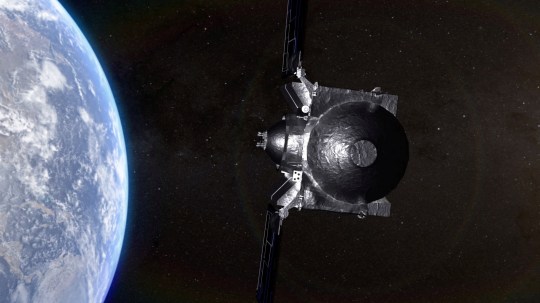If you were outside just before the strike, you might see a trail of light in the sky moving closer for a few seconds to a minute.
By that point, it would be too late to do anything like move to safety. It would be your messenger of the cosmic explosion about to hit, vaporising you and your whole city with the power of dozens of nuclear bombs.
This scenario imagining Earth being hit by a sizeable asteroid isn’t purely a morbid thought exercise. In five years time, one wider than the 330-metre Eiffel Tower will pass closer to us than TV satellites, skimming within 20,000 miles in a stunning near miss.
The space rock known as 99942 Apophis was named after the Egyptian god of chaos and destruction when it was discovered in 2004, because scientists were so worried it might collide with us.
Models eventually showed it would fly back out into space – but there are other asteroids this size in the solar system, and the problem is that we still don’t know how many, or where they could all be heading.
This is why a ‘planetary defence’ mission is underway to fly alongside Apophis when it visits on Friday 13th April 2029, and study how we might be able to deflect another one if it comes on a collision course.
Astronomer Dr Greg Brown, from the Royal Observatory in Greenwich, told Metro.co.uk that if a space rock this size hit a populated area, it would cause catastrophic damage.
‘If it came towards London, then we would be talking about basically wiping out most of the population of London,’ he said. ‘It would be a very big explosion.’
People near the crash site ‘wouldn’t even know it had hit’ as they would be immediately blasted to pieces. Buildings across the city would be leveled and millions would die if astronomers hadn’t spotted it coming in time for them to evacuate, while the whole of the South East of the UK would be badly affected and a dust cloud would be visible for many miles.
‘I would imagine large parts of Europe would be aware it had occurred,’ Dr Brown said, comparing it to a large volcanic eruption with the potential to ground flights.
Thankfully, most of the world is not made up of highly populated cities – so even if one did hit us, it would be unlikely to cause apocalyptic levels of suffering.
Dr Brown points out that two thirds of the surface of Earth is covered in water, and even the ‘vast majority’ of the land is sparsely populated: ‘So the chances of an asteroid even of Apophis’s size causing very large numbers of fatalities is actually remarkably small.’
It is still a possibility, however, and this is why Nasa and the European Space Agency are working on planetary defence missions to study asteroids’ composition and behaviour.
Even if the chances are tiny, the worst case scenario is bad enough to make it worth their while.
The damage an asteroid can do is directly related to how big it is, with the largest ones having the potential to wipe out humanity, and small ones not a concern because they burn up in the atmosphere.
Earth’s most famous asteroid strike didn’t destroy the dinosaurs purely from the explosion. Measuring at least 10km wide, it is thought to have sent up so much dust that it blocked out the sun, killing off plants and in turn the herbivores which ate them.
Although a smaller asteroid the size of Apophis wouldn’t cause this climate effect worldwide, it could still affect farming and light levels locally, and cause a major crisis.
The good news is that scientists believe they have tracked all the ‘planet killers’ in the vicinity which would lead to a mass extinction event, and none show any indication of coming close.
And the less good?
‘We know that we are missing a large fraction of the mid-size asteroids,’ Dr Brown explains, saying these are the ones which measure up to around 400 metres across. ‘The number we know about is a lot lower than the number we think there should be.’
This is worked out from looking at the number of big asteroids, which are easier to spot in space, and the number of small asteroids which actually come and meet us as shooting stars and meteors.
The European Space Agency warned last year: ‘Hidden in the glare of our Sun are an unknown number of asteroids, on paths we do not know, many of which could be heading for Earth, and we just don’t know it.’
Only last month, on June 29, an asteroid measuring around 150 metres whizzed closer to Earth than the Moon, around 295,000km from our planet’s surface. Named 2024 MK, we only spotted it and realised it was coming 13 days earlier, on June 13.
Advancements in technology including AI are sure to help us map the asteroids in our neighbourhood, but for now there is still an element of crossing our fingers.
In 2013, nobody saw the Chelyabinsk asteroid coming until it appeared in the skies, exploded and broke up in the atmosphere before it could hit the ground above the Ural Mountains in Russia.
It was the first major asteroid strike to be caught on video, with dash cam footage showing it speeding through the sky.
The strike injured around 1,500 people, mainly because they saw a flash and went to their windows to see what was going on. When the shockwaves reached the ground a full two minutes later, they were hurt by glass breaking.
This asteroid was around 20 metres across, and blasted apart with 35 times the force of the nuclear bomb which hit Hiroshima at the end of World War Two.
At an estimated 375 metres across (compared to the 300-metre Eiffel Tower), Apophis is around 17 times larger and at the top of the range for the mid-size category.
Something like this would hit with a ‘much bigger’ explosion than Chelyabinsk and would be ‘absolutely devastating’ to the local area, Dr Brown said.
Most asteroids – ancient rocks orbiting the sun – are concentrated in a belt between Mars and Jupiter. But there are thought to be more than 35,000 Near-Earth Objects, mainly asteroids, which might possibly cross into our path.
It might surprise (and reassure) you to know that even if an Eiffel Tower-sized asteroid did hit Earth, you would probably be fine.
Dr Brown said that if it hit the ocean on the other side of the world, you probably wouldn’t even notice, except from the TV reports which would undoubtedly follow.
Those living on the rim of the Pacific could risk tsunamis, and there could be associated disruption in a globalised world, but ultimately people in the UK would go about their business.
Even if it hit land, as long as it was in a rural area, then it shouldn’t cause unimaginable death and destruction, much like nuclear tests held in the desert.
When Apophis passes us, it will be visible to the naked eye as a bright point of light, like a star moving through the sky.
Simulation models have determined it will visit again in 2036 and 2068, but won’t pose a risk of collision for at least 100 years. The limited time frame is not because it is deemed likely to hit us a century from now, but because simulations become less accurate the further into the future they go.
Its upcoming rendezvous 31,860km from Earth will be so close that scientists estimate it happens only around every 5,000 to 10,000 years, so they want to make the most of the chance to study it.
Nasa proved it was possible for humans to shift the orbit of an asteroid by intentionally colliding with 170-metre Dimorphos at 14,000 miles per hour in 2022. The space agency will send a spacecraft to Apophis too, although not to try and deflect it this time. It will be part of the Osiris-Apex operation (an update to the Osiris-Rex mission, which took samples back to Earth from the asteroid Bennu).
The European Space Agency has also taken on a ‘planetary defence’ mission to meet Apophis as it passes by us and announced last week that it’s starting work on Ramses, the Rapid Apophis Mission for Space Safety.
The aim is to learn more about the asteroid both before and after it passes earth, and hopefully work out how to divert a similar space rock if we do find it on a collision course.
Dr Brown said: ‘Although the chance of a particularly big impact happening anytime soon is slim, it is unfortunately never zero.
‘So it’s worth us continuing to try to map all of those asteroids and get to the point where we know where pretty much every one of them is – just in case.’
Get in touch with our news team by emailing us at webnews@metro.co.uk.
For more stories like this, check our news page.
MORE : Scientists discover common bacteria that can melt 99% of cancer cells
MORE : AI brought my friend back from the dead – he told me he was in hell
MORE : Lego Space toys are beaming kids’ sci-fi dreams into the cosmos
Get your need-to-know
latest news, feel-good stories, analysis and more
This site is protected by reCAPTCHA and the Google Privacy Policy and Terms of Service apply.



















